Filed as Classical Fencing, Destreza (Spanish swordplay), Fencing, General, Historical Fencing, Italian Rapier with 9 replies
(8/31/2009)
LINK TO ARTICLE 1
LINK TO ARTICLE 2
Other Martial Traditions
In Aikido the term “Ma-ai” refers to the distance (or interval) between two adversaries. Distance in Aikido is set by your adversary’s ability to strike you. If the adversary holds a weapon like a knife, Ma-ai distance is increased to account for the greater range of the threat.
By contrast, in the Italian fencing tradition distance is typically understood as the distance your attack must travel to strike the adversary.
Close Distance or Narrow Measure– Without moving the feet the adversary may be struck by extending the weapon arm.
Correct Distance or Wide Measure– The adversary may be struck with a lunge.
Out of Distance – The adversary cannot be struck without moving forward.
The key difference between the Japanese measure and the Italian one is the emphasis it places on the conflict. The practitioner of Aikido evaluates the distance needed to defend oneself and the Italian evaluates his own ability to strike. Each martial artist will evaluate offensive and defensive measure, but the measure which is codified provides us an indication of the focus of the art.
The Spanish break distance down into two separate categories using both the concepts of defensive distance used in Aikido and offensive distance used in Italian fencing. Like the Aikido practitioner, the first measure of concern to a Spanish fencer will be the defensive distance.
The Measure of Proportion (Defensive Distance or Place)
(En español – Medio de Proporcion )
This is the closest distance to the adversary in which you may still effectively observe and react to possible threats. The Measure of Proportion should consider the weapon being used by the adversary and their physical stature. It is very unlikely that two opponents will have exactly the same Measure of Proportion.
When Pacheco defined the Measure of Proportion he used the relationship between the two weapons as his guide. He advocates setting the distance so that when the adversary extends his arm at full reach, the point of his weapon reaches no further than the cross of your own weapon. If two opponents have equal bodies and equal swords, they will share the same Measure of Proportion.
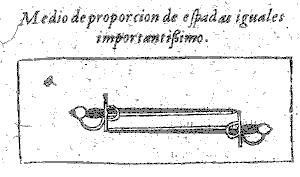
"Measure of proportion when the swords are of equal length - very important" - Pacheco
If the opponent has a longer weapon, how you set your own distance should change and your goal becomes to prevent the adversary from closing the distance so that their threat passes the cross of your weapon. The physical size of the adversary is also considered when setting the distance. For example, an opponent with long legs will have a long lunge and the Measure of Proportion will change to compensate.
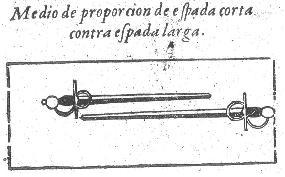
"Measure of proportion for a shorter sword against a longer sword." - Pacheco
When your weapon is longer than the adversary’s your goal in setting distance is to close measure enough to maintain your own Measure of Proportion while violating the defensive distance of your adversary and continually keeping them threatened.
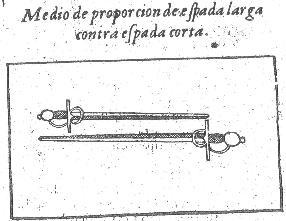
"Measure of proportion for a longer sword versus a shorter sword" - Pacehco
Ettenhard, one of Pacheco’s students, later provides a more nuanced description of this distance which is based on a principle rather than setting defensive measure based on the cross of the sword.
| To choose the Measure of Proportion is to determine a proportionate and convenient distance from which the Swordsman can recognize the movements of his opponent, since for whatever determination of his, there should proceed, of body like of arm and Sword: Of body, by means of footwork: and of Sword, by means of the formation of the Technique. |
Restated, the Measure of Proportion must be chosen so that the fencer can recognize a threat from the adversary. You can anticipate the adversary’s actions if you provide yourself enough distance (and therefore time) to recognize motions of the sword or body.
The Measure of Proportion and the Circle
It is important to remember that all the aspects of the Spanish Circle are defined by setting the Measure of Proportion.
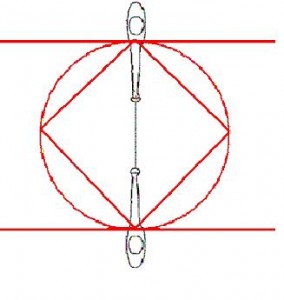
The Measure of Proportion defines the Diameter which also defines the Circle, the Square, and the Lines of Infinity.
You should also note that when two adversaries have a different Measure of Proportion, they will have different preferred Diameters and the circle each wishes to create will be defined differently. This indicates again that arbitrarily “walking the circle” isn’t a reflection of the canonical Spanish tradition. Each fencer will attempt to create a more favorable circle which describes the possible footwork and counter-footwork in a fencing action.
As a common practice “walking the circle” would require not only two identical opponents with identical weapons, but also a choreographed plan in which neither fencer took advantage of the shorter distance gained when the adversary steps along the circle (as shown in Part 2). Instead the opponent would need to continually step away from the adversary to artificially preserve the ideal distance in the circle. Walking around a circle while within the striking distance of a non-cooperative adversary would be dangerous.
In order to close distance by stepping along the circle, the action should either control the adversary’s weapon as you move forward or take advantage of a Movement provided by the adversary (such as the thrust into the diagonal reverse shown in Part 1).
The Proportionate Measure (Offensive Distance or Place)
(En español – Medio Proporcionado )
This is the distance that must be covered to deliver a specific attack. For example the Proportionate Measure of thrusts will be different when using a pike, a sword, and a dagger. By using some of Euclid’s work we can provide a demonstration of which attack and position of the arm has the greatest reach.
The Right Angle
Carranza demonstrates here that the Line from B to A has the greatest reach. This line is called the Right Angle and provides us with effective offense, counteroffense, and defense.
If the blade is lifted from the Right Angle, as shown in the line from B to G, we have entered the Obtuse Angle and our reach has decreased.
If the blade is lowered from the Right Angle, as shown in the line from B to F, we have entered the Acute Angle and our reach has decreased again.
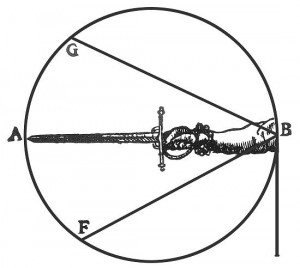
Carranza uses Euclid to demonstrate distance.
The thrust typically has the most reach and will have the most favorable Proportionate Measure. In order to reach the correct distance to execute the thrust you may need to gain control of the adversary’s weapon and step along the Square (Transverse Step) or along the Circle (Curved Step). If the adversary prepares a cut, you can strike with a thrust into his preparation and then quickly retreat. By fencing with an extended arm, the Spanish fencer enjoys an advantage in the number of Movements (and therefore Time) when working against an adversary that cuts.
The Spanish cuts (both full circular cuts and the half cuts) are usually actions that occur when the blade has already moved from the Diameter because of a defensive action or because the adversary has deviated your weapon. These typically have less reach than a thrust but correctly executed can be very powerful. Ettenhard indicates that cuts to the head are more common and that horizontal cuts to the body are dangerous and unusual in practice. Because the Proportionate Measure of a cut is larger than that of a thrust, you should never use the cut as your initial action. The greater number of Movements in the cut expose you to counterattack by the thrust. (Remember that an advantage in the count of Movements is also an advantage in Time.)
The Disarm (Movement of Conclusion) requires you to be close enough to seize the adversary’s hilt with your left hand. This typically requires passing forward with your rear foot and the distance you must travel to successfully execute a disarm can actually carry you to the opponent’s Line of Infinity. Because the Proportionate Measure is greater for the disarm, there is a greater degree of danger involved for a fencer executing the disarm.
Final Notes
Remembering the Terms – The two terms Measure of Proportion (Defensive Distance) and Proportionate Measure (Offensive Distance) can easily be confused. At the risk of being slightly silly, I offer the following mnemonic to help remember the difference between the two.
“When asked of his defense, the aggressive fencer ate his opponent.”
- You can remember defensive measure because it has an ‘of’ in the term – Measure of Proportion
- You can remember offensive measure because it has an ‘ate’ in the term – Proportionate Measure
Angle as Position – The angle of the weapon (Acute, Right, or Obtuse) is a common way of describing the position of the weapon in space. You will see the same anglular terms used to describe position in Destreza texts for different weapons, such as the single sword and even Montante.
Filed as Classical Fencing, Destreza (Spanish swordplay), General, Historical Fencing, Italian Rapier, Movie Reviews, Opinion, Reviews with 12 replies
(8/24/2009)
LINK TO ARTICLE 1
In the Italian tradition there is an imaginary Line of Direction that describes the shortest path to the adversary.
The Spanish tradition uses this line and expands on the concept to create a 2D planar map of possible footwork laid out in a circle. The Spanish Circle is one of the defining elements of the science and various authors have presented it differently while preserving the core concept.
Carranza’s Circle

Carranza’s Circle from his text in 1569.
Here is the same image with labels to provide us a reference.
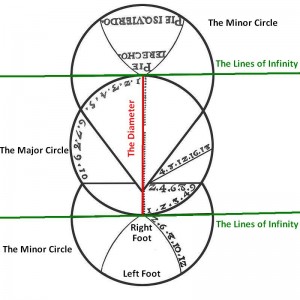
Carranza’s Circle with Labels
The Diameter – The imaginary line separating the two fencers is called the Diameter. It represents the shortest path to the target. The Diameter starts at the lead toe of the fencer (bottom of the red line) to the the lead toe of the adversary (top of the red line). The correct length of the Diameter should be the distance at which the fencer can observe the adversary’s offensive actions and still respond in time.
The Major Circle (Greater Circle) – The central circle shown between the two fencers is called the Major Circle or sometimes just the Circle. By rotating the Diameter about its center, we can create an imaginary circle which functions as a one piece of a footwork map.
The Lines of Infinity– The two parallel lines shown in green are called the Lines of Infinity or Infinite Lines. In the same manner as the Diameter, the distance between these lines is defined by your ability to observe and react to the adversary’s offense. Crossing the Line of Infinity means closing distance into the adversary’s offensive measure.
The Minor Circle – The smaller circles on either side of the Major circle are called the Minor Circles. The fencer and the adversary each stand in the center of a Minor Circle which is defined by the positions of the feet.
The Circle represents a moment of fencing time – The circle is not fixed in location, but instead describes the distance and possible steps within a specific fencing action. Just as the Italian Line of Direction changes when the adversaries move, so to does a new circle occur when the fencers change position. If an adversary has broken your defense and closed measure, the text may advise you to step onto a new circle and this represents the need to reestablish correct distance.
Pacheco’s Circle
Later Pacheco describes a similar circle. Note that the origin point for the fencer is at one end of the diameter (bottom of the circle) while the adversary stands on the opposite side (top of the circle).
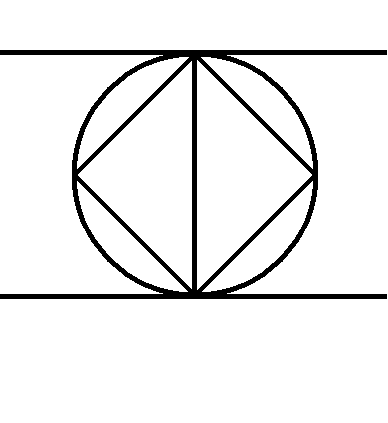
Pacheco’s Circle as shown in his book in 1600.
The primary addition to the Circle is the Square which like the angular lines above in Carranza’s Circle provide us with another indicator for footwork.
We can also map a series of vectors onto this planar diagram which allows us to precisely describe footwork. Remember that a vector is a line with direction and magnitude.

A vector that indicates motion to the right of the reader. (This vector has an undetermined magnitude.)
General Notes
The Spanish treat a step as a motion that starts in stance and ends in stance which requires a motion of each foot. When the fencer moves only one foot, this is specified in the description of the footwork.
To compare this to Italian fencing, we know that an advance starts in the guard and requires a movement from the lead foot followed by the rear foot returning to the guard. Likewise a retreat starts in the guard and requires a movement from the rear foot followed by the lead foot returning to the guard.
By contrast, when an Italian fencer executes a lunge, the fencer starts in the guard and moves only the lead foot. The final position of the lunge is not the guard.
Forward Step
(En español – Compas Accidental )
The fencer advances along the line of the Diameter.
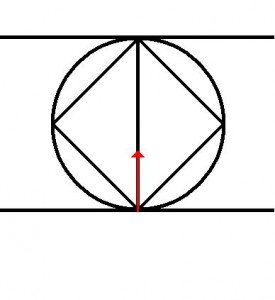
Forward Step (advance)
Backward Step
(En español – Compas Extraño )
The fencer retreats in line with the Diameter.
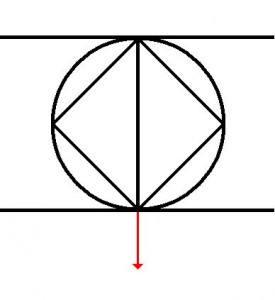
Backward Step (retreat)
Lateral Step
(En español – Compas de Trepidacion)
The fencer steps along the Line of Infinity either to the left or right. When stepping towards a direction, unless directed otherwise, the fencer will avoid crossing the feet. For example, when stepping to the right, the fencer will lead with the right foot. When stepping to the left, the fencer will lead with the left foot.
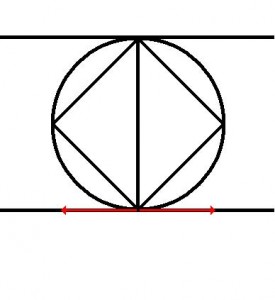
Lateral Step (sidestep)
Curved Step
(En español – Compas Curvo)
The fencer steps along the Circle either to the left or right. When stepping towards a direction, unless directed otherwise, the fencer will avoid crossing the feet. For example, when taking a Curved Step to the right, the fencer will lead with the right foot. When taking a Curved Step to the left, the fencer will lead with the left foot. At the completion of the Curved Step, the fencer should be in profile facing the adversary.
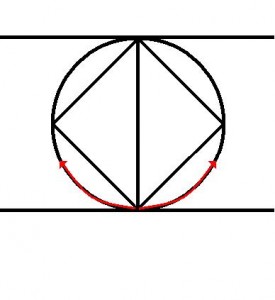
Curved Step
IMPORTANT NOTE: There is a misconception that stepping along the circle does not close distance. This is demonstrably incorrect as shown with this simple triangle in green, purple and blue overlaid on the circle.
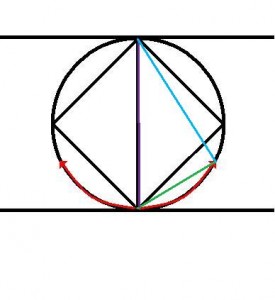
The blue line of the triangle demonstrates the Curved Step has gained measure. The blue line is clearly shorter than the Diameter.
If you step along the circle you should be aware that you have entered the adversary’s range. Walking along the circle without reason provides your adversary with one unit of fencing time with each step and I don’t recommend it.
A Curved Step along the circle is a common method of gaining ground gradually and is often used in response to an offensive action from the adversary.
For example, if the adversary executes a cut, we may intercept the attack with the blade and then step forward along the circle to deliver a riposte. Because the adversary has moved forward already, our step moves only slightly forward and takes us off the line. After we have delivered a riposte, we might back away safely past the Line of Infinity.
Transverse Step
(En español – Compas Transversal)
The Transverse Step is a type of angular advance either to the left or right along the square shown inside the circle. The Transverse starts with the lead foot and is followed by the rear foot. At the completion of the Transverse Step, the fencer should be in profile facing the adversary. When there is an exception to this, it is stated in the description of the step and may be called a Mixed Step (See below).
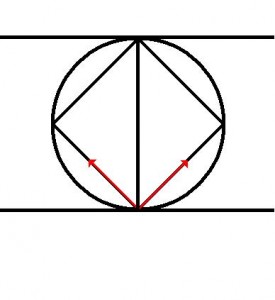
Transverse Step (angular advance)
The Transverse Step closes distance more aggressively than the Curved Step shown above and is typical of offensive actions or attacks into the adversary’s preparation.
Mixed Step
(En español – Compas Mixto)
A Mixed Step is a combination of two other types and are often angular retreats either to the left or right away from the circle.
Two common examples of Mixed Steps are Mixed Backwards and Lateral to the left or Mixed Backwards and Lateral to the right. In this case, the Mixed Step starts with the rear foot and is followed by the lead foot. At the completion of the Mixed Step, the fencer should be in profile facing the adversary.
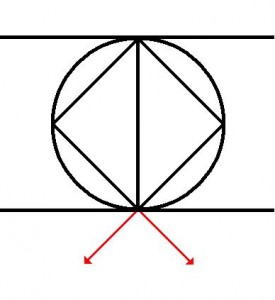
Mixed Step Backward and Lateral (angular retreat)
Another common Mixed Step is the Transverse Step to the Left using the right foot, followed by a Curved Step with the left foot.
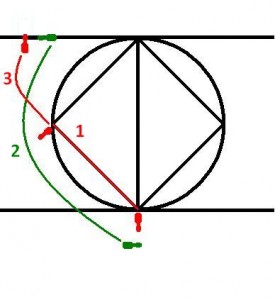
Mixed Step Transverse Left and and Curved Left (angular advance with passing step)
This image is my copy of a Circle from Ettenhard’s book in 1675 which describes the footwork.
1. The lead foot takes a Transverse step along the square pre-turning the lead foot to point back to the adversary. (The weight rests on the ball of the lead foot.)
2. Pivoting on the ball of the front foot, the rear foot moves in an arc landing on the adversary’s Line of Infinity.
3. The lead foot passes behind the left executing another pivot and placing the fencer in profile with respect to the adversary on his Line of Infinity.
Other Footwork
Other footwork is explicitly described in the text.
For example:
The Italian gaining step would be described as “bringing the rear foot forward close to the heel of the right foot.”
The Italian lunge would be described as “an extreme forward step of the lead foot while keeping the rear foot fixed.”
Opposition of Footwork
According to Ettenhard,
- The Forward Step is superior to the Backward Step
- The Forward Step is defeated by the Transverse, Curved, Lateral, and Mixed Backward and Lateral Steps. (Stepping off the Line of Direction will defeat an advancing opponent.)
- The Transverse and Curved Steps can be defeated with the Transverse and Curved Steps. (When an adversary circles toward you, either moving into them or circling away can defeat their action.)
Application to other Traditions
Again this material can be tradition agnostic. Using the Spanish Circle as a footwork map provides us with a useful guide for describing to a student how fast we want them to close measure. We can also advise the student to step inside the square or outside of it provide more nuance.
In addition, the Spanish codify angular and circular footwork which has been largely excluded from modern fencing traditions. As Ettenhard states, countering a circular step with a circular step is a good solution and we see this understanding in Destreza, Aikido, and many other martial arts.
Filed as Destreza (Spanish swordplay), Fencing, General, Historical Fencing, Italian Rapier with 8 replies
(8/20/2009)
In the Italian fencing system, fighting is broken up into pieces of time called “tempi” or “fencing times” in English. For example, a fencing action might take place in a single tempo (one unit of fencing time), mezzo tempo (a half tempo), or due tempi (two times). It is a useful tool for teaching timing to a student and an action with less tempi is generally considered more desirable.
The Spanish fencing science takes the idea of tempi even farther by using a vector-based system of notating actions through movements.
Aristotle states in his book Physics “Time is the numeration of continuous movement.”
By this definition, we can reexamine tempi as the summation of different motions. In the Spanish science all fencing actions are described as “movements.” There are movements of the blade and footwork to move the body. By using the two together, we can not only understand fencing time, we can also create a shorthand notation for describing complex actions and their counters.
The Spanish fencing authors describe blade actions as a series of varying length vectors through space. To be more clear a vector is a line with magnitude and direction.

A vector that indicates motion to the right of the reader. (This vector has an undetermined magnitude.)
This allows the Spanish notation to be extremely precise when describing the motions of the blade associated with specific actions like cuts, the Atajo, or even Italian actions described by Spanish authors.
To better illustrate this, observe this map of three dimensional space with a sword pointed along the Diameter (or Line of Direction) towards the adversary.
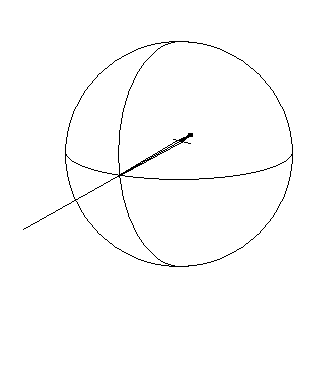
Map of 3D space
Natural Movement
(En español – Movimiento Natural )
A Natural motion is one in which the blade falls to the earth. More specifically, the blade is lowered. One example would be a vertical cut downwards.
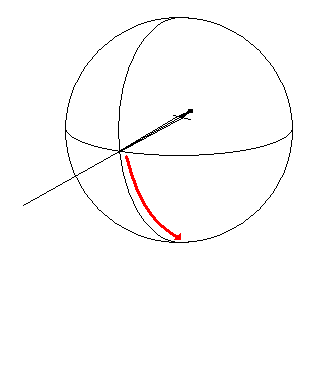
In a Natural Movement the blade is lowered.
Violent Movement
(En español– Movimiento Violento)
A Violent motion is one in which the blade rises. One example might be the chambering of a vertical cut.
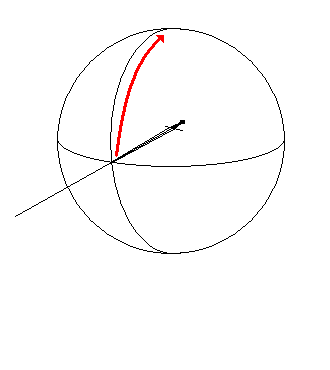
In a Violent Movement the blade is lifted.
Forward Movement
(En español – Movimiento Accidental)
A Forward motion is when the blade travels toward the adversary along the Diameter (Line of Direction). One example would be a thrust.
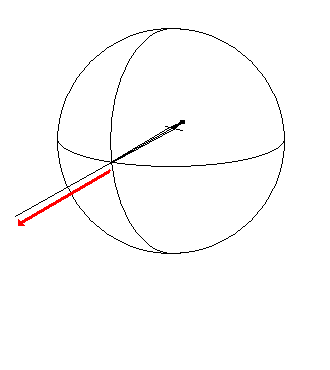
In a Forward Movement the blade travels towards the adversary.
Backward Movement
(En español – Movimiento Extraño)
A Backward motion is when the sword is withdrawn away from the adversary along the Diameter (Line of Direction). One example might be pumping the arm back to execute a jabbing attack. (This is not a recommended action, and Don Luis Pacheco de Narváez describes how to defeat this pumping of the weapon arm in an adversary.)

In a Backward Movement the blade travels directly away from the adversary.
Offline Lateral Movement
(En español -Movimiento Remiso)
An Offline Lateral motion is when the point of the weapon is carried away from the Diameter (Line of Direction) either to the left or right. Notice that the Spanish create a special case for movements that bring the point away from the target. It might be tempting to merely use lateral movements as descriptors but the Spanish notation relates specifically to removing the threat from the adversary. This might be a parry or the chambering of a horizontal cut.
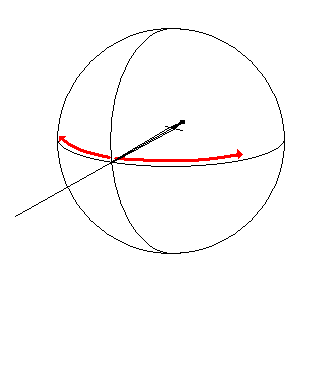
In an Offline Lateral Movement the blade travels either right or left away from the adversary. (The act of removing the point from presence to one side or the other.)
Aligning Lateral Movement
(En español – Movimiento de Reducción)
An Aligning Lateral motion is when the blade is returned from either the left or right back to the Diameter (Line of Direction). It is interesting to note that bringing the weapon across the Diameter is counted as two distinct movements. If the point is offline, bringing it towards the Diameter is an Aligning Lateral Movement, but when it crosses the Diameter and continues traveling in the lateral plane without stopping this becomes an Offline Lateral Movement. This is very useful for indicating the different tactical situations that are possible when a blade is leaving or entering presence. An Aligning Lateral Movement might be the delivery of a horizontal cut or bring the weapon back into line after the adversary has executed a beat.
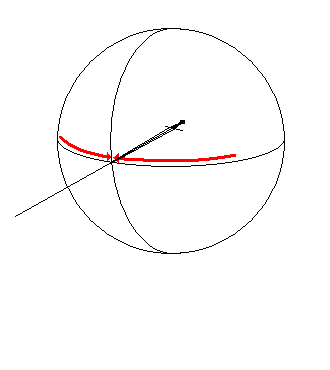
In an Aligning Lateral Movement the blade travels either right or left towards the Diameter and towards the adversary. (The act of returning the point into presence from one side or the other.)
Mixed Movement
(En español – Movimiento Mixto )
A Mixed Movement is a single motion that is a combination of two blade movements that don’t conflict. For example an Offline Lateral Movement can be mixed with a Violent Movement in a single motion to form a Mixed Movement.
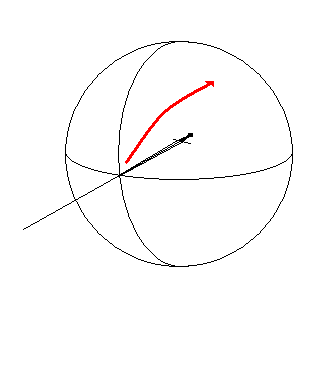
In this image we see a mixed Movement consisting of a Violent Movement and an Offline Lateral Movement in a single Mixed Movement.
Counting Time Through Motion
Like the Italian system we can count time using the Spanish notation. An action with fewer movements is more desirable than an action with a greater number of movements.
Let’s compare two actions:
Diagonal Reverse (Riverso Squalembrato in Italian)
- Mixed Movement combining an Offline Lateral Movement to the left and a Violent Movement in order to chamber the cut over the left shoulder
- Mixed Movement combining an Aligning Lateral Movement and a Natural Movement to deliver the cut
Thrust
- Forward Movement along the Diameter to deliver the thrust
Description of Defense or Counteroffense
Because the Thrust requires fewer movements than the Diagonal Reverse it can defeat the cutting attack in the first movement. In addition, we can use the counted movements of the adversary’s action to give the reader a guide to the timing of defense or counteroffense.
For example:
Countering the Diagonal Reverse
In the adversary’s first movement as the cut is chambered the fencer may strike with a thrust.
During the adversary’s second movement, the fencer may defend by placing the Atajo.
Final Notes
The Spanish notation is system agnostic so it can be applied to any weapon or tradition of fencing. In historical Spain, authors used this notated system of Movements to describe the actions of the single-handed sword and the two-handed sword called the Montante. The AEEA fencers in Spain today also use Destreza’s science and notation to analyze and teach the swordplay of other non-Spanish authors as well like Fiore.
~Puck
Filed as General, Opinion, Politics and News with 26 replies
(8/18/2009)
I thought it might be fun to spread my own wild and unsupported accusations in the Health Care debate. In order to get us there, we need to look a bit at the public defenders first.
|
“You have the right to remain silent. Anything you say can and will be used against you in a court of law. You have the right to an attorney present during questioning. If you cannot afford an attorney, one will be appointed for you. Do you understand these rights?“
|
Mirandizing
This quote above is a typical script used when arresting someone in the United States. To understand this script we need to understand two landmark cases from the 1960s.
Gideon versus Wainwright (1963)
This ruling guarantees the right of a public defender and here are two key portions of the ruling:
|
“Not only these precedents, but also reason and reflection, require us to recognize that, in our adversary system of criminal justice, any person hauled into court, who is too poor to hire a lawyer, cannot be assured a fair trial unless counsel is provided for him.”
|
|
“The right of one charged with crime to counsel may not be deemed fundamental and essential to fair trials in some countries, but it is in ours. From the very beginning, our state and national constitutions and laws have laid great emphasis on procedural and substantive safeguards designed to assure fair trials before impartial tribunals in which every defendant stands equal before the law. This noble ideal cannot be realized if the poor man charged with crime has to face his accusers without a lawyer to assist him.“
|
Miranda versus Arizona (1963)
Here is a key piece of this ruling:
|
“The person in custody must, prior to interrogation, be clearly informed that he has the right to remain silent, and that anything he says will be used against him in court; he must be clearly informed that he has the right to consult with a lawyer and to have the lawyer with him during interrogation, and that, if he is indigent, a lawyer will be appointed to represent him.“
|
The Safety Net
The key idea here is that the poor had no legal safety net and our government provided for their protection in the courts. What the poor have in legal representation many of us lack with regard to health care.
There is no basic health safety net and we instead practice a draconian form of Social Darwinism that affirms that the poor deserve no protection because of their own lack of ability to produce enough income to pay for it.

Herbert Spencer
|
“The poverty of the incapable, the distresses that come upon the imprudent, the starvation of the idle, and those shouldering aside of the weak by the strong, which leave so many “in shallows and in miseries,” are the decrees of a large, far-seeing benevolence. It seems hard that an unskilfulness which with all his efforts he cannot overcome should entail hunger upon the artisan. It seems hard that a laborer incapacitated by sickness from competing with his stronger fellows, should have to bear the resulting privations. It seems hard that widows and orphans should be left to struggle for life or death. Nevertheless, when regarded not separately, but in connection with the interests of universal humanity, these harsh fatalities are seen to be full of the highest beneficence—the same beneficence which brings to early graves the children of diseased parents, and singles out the low-spirited, the intemperate, and the debilitated as the victims of an epidemic.” ~Herbert Spencer (1851)
|
Boiled down to the core idea, wealth = merit. There is no need to feel any concern over the suffering of others because it is actually good that these weaker people (widows, orphans, etc.) die.
There has been plenty of frothing hysteria and misinformation from the right wing about what a public health care option would bring to the country. If we compare a public health care option to the public defender system we might get a better understanding of how it might work.
Socialism
|
Socialized Medicine – This is a big deal for the right wing and the insurance companies actively try to play up the idea of a completely nationalized medical system like China’s. This isn’t remotely what is being proposed and to suggest otherwise is lying. What is being suggested is an optional government sponsored insurance program that scales the fees to meet the individual’s needs. People who don’t make enough money to pay the premium receive the coverage at no charge and it functions as a safety net. People who want to continue their current coverage aren’t directly affected (although it may lower their premiums as insurance companies try to compete against the public plan). Nothing about offering public health insurance implies a government seizure of the medical system.
|
|
Socialized Public Defenders – All lawyers work for the government and lawyers are assigned to cases by the government.
|
Rationing
|
Medical Rationing – This is a convenient shell game in which the proposed free medical coverage is instead portrayed as a removal of existing medical care for everyone. In this argument the government will ration all medical care. (It neglects the current situation where 7 large corporations seeking a profit already ration your medical care and try to rescind existing policies that become too expensive.)
|
|
Public Defender Rationing – Only a certain number of cases will be granted a public defender. The remainder of defendants will be required to defend themselves or will be found automatically guilty.
|
Bankruptcy
|
Bankrupting Insurance Companies – This myth promotes the idea that everyone will immediately turn to a public option and the insurance companies will go bankrupt. As much as I might like this to be true, it is pretty unlikely. We have had Public Defenders for over 40 years and private attorneys seem to be doing just fine. Imagine Coca Cola, Microsoft, or Exxon using a public defender and you can see how laughable this really is. I haven’t seen FedEx or UPS go out of business yet even as they compete with our socialized postal service. This is capitalism at its finest.
|
|
Bankrupting Lawyers – Public Defenders are free and therefore all private attorneys will go out of business.
|
Bureaucrats
|
Government Mandated Medical Decisions – This is the classic “government bureaucrat between you and your doctor” argument created by the private insurance companies. This is particularly heinous considering insurance companies have actually pulled patients off of operating tables mid-surgery to deny medical claims. While the idea of a government bureaucrat sounds scary, what we have today is a corporate suit trying to make a profit and that is much worse.
|
|
Government Mandated Public Defense Decisions – A government bureaucrat decides what you will plead in each case and makes decisions about your legal strategy.
|
Loss of Benefits
|
Losing your existing Coverage – In this myth, the government removes your existing coverage and forces you into the public option using government doctors. No one has suggested anything but adding an additional public insurance plan to cover those without insurance.
|
|
Losing your existing Lawyer – The government fires your existing lawyer and forces you to use a public defender.
|
Obama Wants to Kill Your Gramma!
|
Death Panels – This particular piece of hysteria has been Sarah Palin’s newest talking point. In the Palin-Reality the government will create a panel concerning end-of-life decisions with the power to euthanize you or your children. This seems to be inspired by an option in the current bill that permits doctors to receive Medicare compensation for voluntarily discussing living wills with patients. Let’s just say that Sarah Palin’s reality is not to be confused with actual reality.
|
|
Public Defender Vigilantes! – Public Defenders chase down suspected criminals and execute them on sight.
|
This current discussion is a lot more about trying to bring Obama down than it is about the evils of socialism. In any case providing a public insurance option is not socialism any more than the U. S. Postal Service, the Police, Firefighters, or the public defenders are socialism. What we have seen is that when the neoconservatives on the right-wing disagree with you they:
- Lie
- Shout down any debate
- Bring assault rifles to political town hall meetings
Filed as General with no replies
(8/11/2009)
Since puppyhood my dog has wanted to meet and love on cats. It started when she discovered my friend Cindy’s kitten Elbie and tried to give her a sniff. Elbie whapped Shakti on the nose so quickly that my dog had no idea what hit her.
She hasn’t had any luck sniffing or loving on cats since then and you can imagine how an affectionate 140-pound dog might intimidate a cat. Shakti tends to show her affection by bumping you with her nose or leaning on you and most cats hate that kind of thing.
Shakti has been staying with my wife’s parent’s this year and by a happy coincidence some kittens were born this year at the house. The Great Dane has finally gotten a chance to play with some cats that were not intimidated and you can see the results below.

Shakti loving a kitten

Shatki hugging a kitten

Shatki loving two kittens

Shakti napping with kittens (click for larger image)































